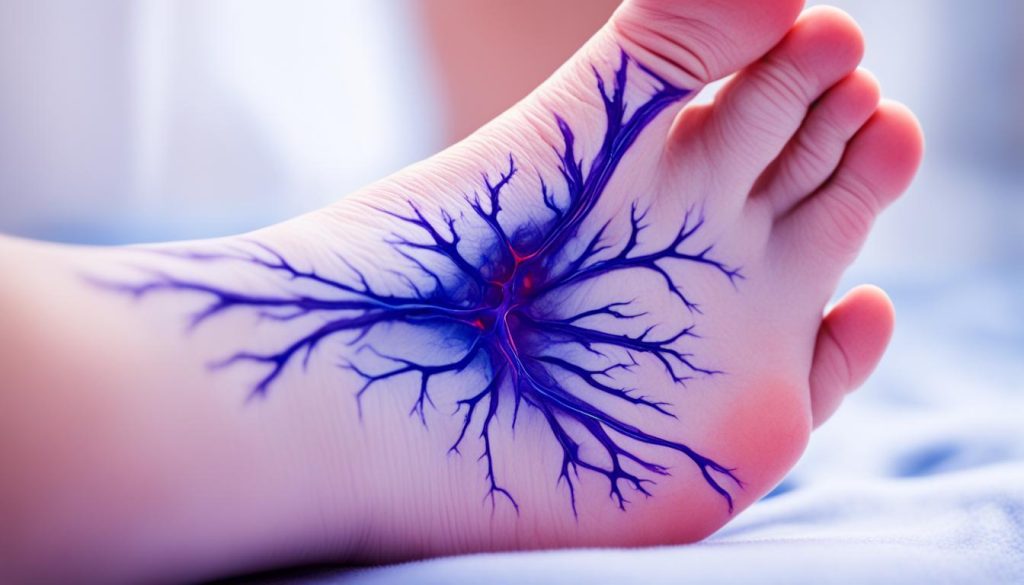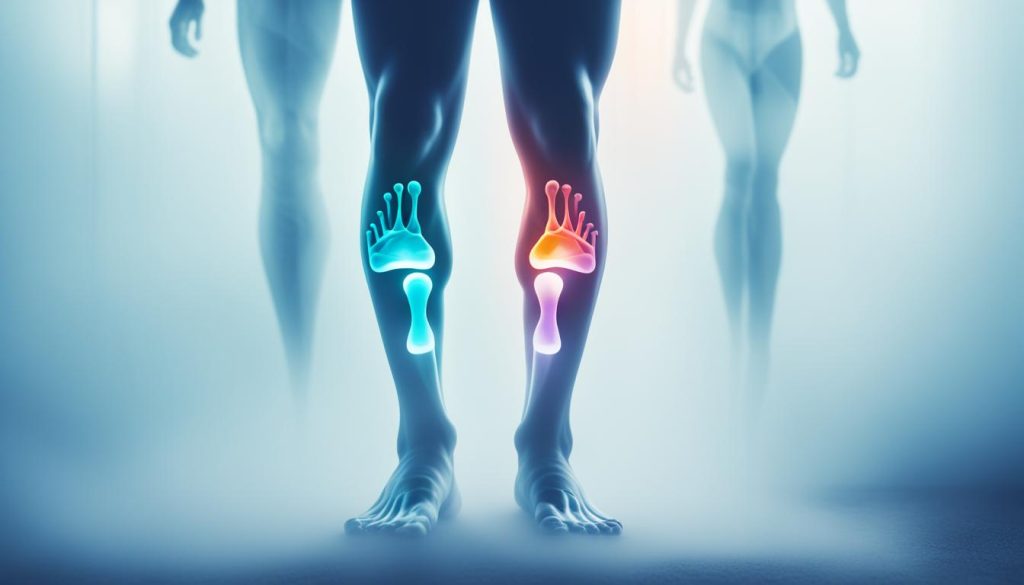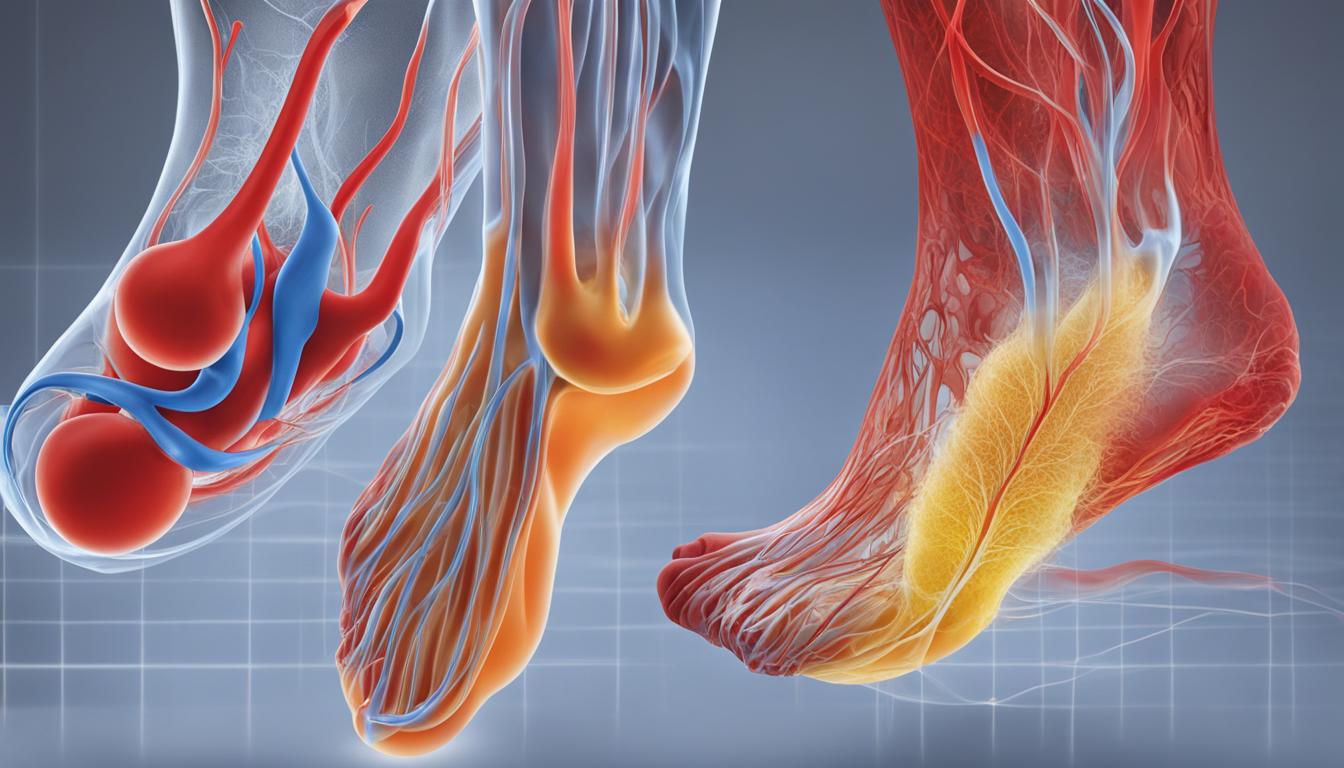Have you ever wondered why your body feels warm, but your feet remain cold? This common phenomenon may be due to various factors, including body temperature regulation and circulation issues. Understanding the causes behind cold feet can help you find remedies and treatments to keep your feet warm and comfortable.
Cold feet can occur as a result of thermal regulation in the body. When exposed to cold temperatures, our blood vessels in the extremities constrict to conserve warmth in vital body parts. This reduced blood flow to the feet can make them feel cold, while the rest of your body remains warm. While this is a normal response to cold temperatures, experiencing cold feet in normal or warm conditions may indicate underlying health issues or poor blood circulation.
Some common causes of cold feet include stress and anxiety, which can constrict blood vessels and restrict blood flow to the extremities. A sedentary lifestyle, smoking, high cholesterol, and heart conditions are also known to contribute to poor circulation, resulting in cold feet. Additionally, underlying health conditions like diabetes, peripheral neuropathy, hypothyroidism, and anemia can affect circulation and lead to cold feet.
To improve circulation and address cold feet, there are several home remedies you can try. Regular movement and exercise can promote blood flow to the feet. Wearing warm socks and slippers, indulging in foot baths, and using heating pads can also help warm up your feet. However, if cold feet persist or are accompanied by other symptoms, it is important to seek medical evaluation to determine any underlying health conditions and receive appropriate treatment.
By understanding the causes of cold feet and implementing remedies to improve circulation, you can ensure greater comfort and warmth for your feet. Remember, if cold feet become a frequent issue, it’s essential to consult a healthcare professional for a proper diagnosis and personalized treatment plan. Stay warm and keep your feet cozy!
Why is My Body Warm but My Feet Are Cold?
Cold Feet and Cold Temperatures
Cold temperatures are a common cause of cold feet. When the body is exposed to cold, the blood vessels in the extremities constrict to reduce heat loss and preserve warmth in vital body parts. This reduced blood flow can cause the feet to feel cold. Some individuals may have Raynaud’s phenomenon, where exposure to cold temperatures or high stress causes limited blood circulation, resulting in cold or numb fingers and toes. While temporary symptoms are usually not serious, experiencing cold feet in normal or warm temperatures may indicate an underlying health problem.
While cold temperatures can be a natural trigger for cold feet, it is essential to differentiate between temporary discomfort and persistent symptoms that may be a sign of an underlying health issue. Understanding how the body regulates temperature and the impact of reduced blood flow to the extremities can help individuals identify and address the causes of cold feet. It is always advisable to consult a healthcare professional for proper diagnosis and guidance.

Body Temperature Regulation and Reduced Blood Flow
To comprehend why cold temperatures can lead to cold feet, it is important to understand how the body regulates its temperature. The human body prioritizes the maintenance of core body temperature for vital organ function. When exposed to cold temperatures, the body initiates protective measures to preserve warmth in critical areas, such as the heart and brain. This regulation is achieved by redirecting blood flow away from the periphery, including the extremities like the hands and feet.
Consequently, the reduced blood flow to the extremities can cause the feet to feel cold. The constriction of blood vessels in response to cold temperatures restricts the amount of warm blood reaching the feet, leading to a temperature imbalance. While this is a natural response to cold exposure, persistent cold feet in normal or warm temperatures may indicate an underlying health concern.
Raynaud’s Phenomenon and Cold Feet
Raynaud’s phenomenon is a condition characterized by reduced blood circulation in response to cold or stress. It primarily affects the fingers and toes but can also extend to other extremities. People with Raynaud’s phenomenon may experience episodes of cold or numb fingers and toes, accompanied by changes in skin color.
During an episode, the blood vessels in the extremities constrict excessively, limiting blood flow and causing cold feet. While the exact cause of Raynaud’s phenomenon is unknown, it is believed to involve an overreaction of the blood vessels to certain triggers. These triggers can vary from exposure to cold temperature to emotional stress or a combination of both.
Raynaud’s phenomenon can be either primary or secondary. Primary Raynaud’s occurs when the condition is not associated with other underlying health conditions, while secondary Raynaud’s is linked to certain diseases or factors, such as connective tissue disorders, autoimmune conditions, or the use of certain medications.
If you experience persistent cold feet or suspect you may have Raynaud’s phenomenon, it is advisable to consult a healthcare professional for proper diagnosis and management of the condition.”
| Cold Feet Causes | Explanation |
|---|---|
| Cold Temperatures | Exposure to cold temperatures can cause the blood vessels in the extremities, such as the feet, to constrict and reduce blood flow, resulting in cold feet. |
| Raynaud’s Phenomenon | In individuals with Raynaud’s phenomenon, exposure to cold or stress triggers excessive blood vessel constriction, leading to limited blood flow and cold feet. |
| Underlying Health Conditions | Various underlying health conditions, such as diabetes, peripheral neuropathy, hypothyroidism, and anemia, can contribute to poor circulation and cold feet. |
| Stress and Anxiety | High levels of stress and anxiety can cause blood vessels to constrict, impeding blood flow to the extremities and resulting in cold feet. |
| Circulation Issues | Poor circulation caused by a sedentary lifestyle, smoking, high cholesterol, or heart conditions can lead to reduced blood flow to the feet and cold feet. |
Stress and Anxiety-Related Cold Feet
High stress or anxiety can be a common cause of cold feet. When the body experiences stress or nervousness, it releases adrenaline into the bloodstream. Adrenaline is a hormone that prepares the body for a high-stress situation by triggering the fight-or-flight response. As a result, blood vessels constrict, reducing blood flow to the extremities like the hands and feet. This constriction can lead to cold feet and a sensation of chilliness.
This natural response of the body is beneficial in immediate high-stress situations as it redirects blood flow to vital organs. However, when stress and adrenaline become chronic, cold feet can become more frequent and persistent, causing discomfort and affecting daily life.
Reducing stress and tension can help alleviate symptoms in these cases. Techniques such as deep breathing exercises, meditation, regular physical activity, and seeking support or counseling can aid in managing stress and anxiety. Additionally, engaging in activities that promote relaxation, such as yoga or hobbies, can contribute to overall well-being and reduce the likelihood of experiencing cold feet.
Tips to Reduce Stress and Alleviate Cold Feet
| Tip | Description |
|---|---|
| Deep breathing exercises | Take slow, deep breaths, inhaling through the nose and exhaling through the mouth. Deep breaths can help calm the nervous system and reduce stress. |
| Meditation | Practice meditation or mindfulness techniques to promote relaxation and reduce anxiety levels. |
| Regular physical activity | Engage in regular exercise, such as walking, cycling, or swimming, to release endorphins and reduce stress. |
| Seek support | Talk to a trusted friend, family member, or mental health professional to share your feelings and receive guidance. |
| Engage in relaxing activities | Participate in activities that bring you joy and help you unwind, such as yoga, reading, or listening to calming music. |
By managing stress and anxiety effectively, individuals may experience improved overall well-being and a reduction in cold feet symptoms. However, it is crucial to consult a healthcare professional if cold feet persist or are accompanied by other concerning symptoms, as they may be indicative of an underlying health condition.

Circulation Issues and Cold Feet
Cold feet can often be attributed to circulation issues in the body. When there is poor circulation, it becomes challenging for warm blood to reach the feet, resulting in the sensation of cold feet. Several factors can contribute to circulation problems:
- A sedentary lifestyle or prolonged sitting can restrict blood flow to the legs, leading to cold feet.
- Smoking tobacco products can hinder blood flow and exacerbate circulation issues, causing cold feet.
- High cholesterol levels can contribute to the formation of plaques in the arteries, reducing circulation to the legs and feet.
- Certain heart conditions, such as peripheral artery disease, can cause insufficient blood flow to the extremities, including the feet, resulting in cold feet.
It is essential to address these underlying factors that can affect circulation. Making lifestyle changes, such as adopting a more active routine, quitting smoking, and managing cholesterol levels, can all help improve circulation and alleviate cold feet symptoms. If you have any existing heart conditions or risk factors, it is crucial to seek professional medical advice for proper diagnosis and treatment.

Underlying Health Conditions and Cold Feet
Cold feet can also be caused by underlying health conditions that affect circulation. Some common health conditions associated with cold feet include:
- Diabetes Mellitus: Diabetes can lead to circulation problems that result in cold feet. High blood sugar levels can cause narrowing of the arteries and reduced blood supply to the tissues, leading to cold feet.
- Peripheral Neuropathy: Peripheral neuropathy is a form of nerve damage often seen in people with uncontrolled diabetes. It can cause various symptoms, including cold feet.
- Hypothyroidism: Hypothyroidism, an underactive thyroid gland, can impact the body’s metabolism and cause sensitivity to cold. Cold feet may be one of the symptoms experienced by individuals with this condition.
- Anemia: Anemia, characterized by a low red blood cell count, can result in insufficient oxygen supply to the tissues, including the feet. This can cause cold feet along with other symptoms like fatigue and weakness.
If you experience cold feet along with any of these underlying health conditions, it is important to consult a doctor for proper diagnosis and treatment. Managing these conditions can help alleviate the cold feet symptoms and improve overall health.

| Underlying Health Conditions | Symptoms |
|---|---|
| Diabetes Mellitus | Cold feet, numbness or tingling in the feet, slow wound healing |
| Peripheral Neuropathy | Cold feet, numbness or tingling in the feet, burning or shooting pain |
| Hypothyroidism | Cold intolerance, fatigue, weight gain, dry skin |
| Anemia | Cold feet, fatigue, weakness, pale skin, shortness of breath |
Conclusion
Cold feet can be caused by a variety of factors, including cold temperatures, stress, circulation issues, nerve disorders, and underlying health conditions. While occasional cold feet are normal, persistent symptoms may indicate an underlying medical condition that requires evaluation and treatment.
Fortunately, there are some home remedies that can help improve circulation and keep the feet warm. Simple actions like regular movement, wearing warm socks and slippers, indulging in foot baths, and using heating pads can provide relief and promote improved blood flow.
However, if cold feet are frequent or accompanied by other symptoms, it is important to consult a doctor for a proper diagnosis and treatment plan. Medical evaluation can help determine if there are any underlying health conditions contributing to cold feet and guide appropriate treatment, ensuring long-term relief and warm feet.
FAQ
1. Why is my body warm but my feet are cold?
Cold feet can be caused by various factors, including cold temperatures, circulation issues, stress, nerve disorders, and underlying health conditions. Reduced blood flow to the extremities, such as the feet, can occur in response to cold temperatures, leading to cold feet. Stress and anxiety can also cause blood vessels to constrict, resulting in cold feet. Poor circulation, which can be caused by a sedentary lifestyle, smoking, high cholesterol, or heart conditions, is a common cause of cold feet. Underlying health conditions like diabetes, peripheral neuropathy, hypothyroidism, and anemia can also contribute to cold feet. It is important to consult a doctor for proper diagnosis and treatment if cold feet are persistent or accompanied by other symptoms.
2. How does cold temperatures affect feet temperature?
When the body is exposed to cold temperatures, the blood vessels in the extremities constrict to reduce heat loss, resulting in reduced blood flow to the feet. This reduced blood flow can cause the feet to feel cold. Some individuals may have Raynaud’s phenomenon, where exposure to cold temperatures or high stress causes limited blood circulation, resulting in cold or numb fingers and toes. While temporary symptoms are usually not serious, experiencing cold feet in normal or warm temperatures may indicate an underlying health problem.
3. Can stress or anxiety cause cold feet?
Yes, high stress or anxiety can lead to cold feet. When the body experiences stress or nervousness, it releases adrenaline into the bloodstream, causing blood vessels to constrict. This constriction reduces the flow of blood to the extremities like the hands and feet, which may result in cold feet. While this response may be protective in high-stress situations that pose immediate risk, it can be more harmful than helpful when it regularly causes cold feet. Reducing stress and tension can help alleviate symptoms in these cases.
4. How do circulation issues contribute to cold feet?
Circulation issues are a common cause of cold feet. Poor circulation can make it difficult for warm blood to reach the feet, resulting in cold feet. A sedentary lifestyle or prolonged sitting can reduce blood circulation to the legs, causing cold feet. Smoking tobacco products can also hinder blood flow and contribute to cold feet. High cholesterol can lead to plaques forming in the arteries, reducing circulation to the legs and feet. Some heart conditions can also result in cold feet. It is important to address any existing heart problems or risk factors and consult a doctor for proper diagnosis and treatment.
5. What underlying health conditions can cause cold feet?
Underlying health conditions can contribute to cold feet. Diabetes mellitus can cause circulation problems that result in cold feet. Long-term high blood sugar levels can lead to narrowing of the arteries and reduced blood supply to the tissues, causing cold feet. Diabetic peripheral neuropathy, a form of nerve damage, is also common in people with uncontrolled diabetes and can cause cold feet along with other symptoms. Hypothyroidism, an underactive thyroid gland, can impact the body’s metabolism and cause sensitivity to cold, including cold feet. Anemia, characterized by a low red blood cell count, can also lead to cold feet. It is important to consult a doctor for proper diagnosis and treatment of these underlying health conditions.
6. What are some home remedies for cold feet?
Several home remedies can help improve circulation and warm up the feet. These include regular movement or exercise to promote blood flow, wearing warm socks and slippers, foot baths with warm water, and using heating pads or warm packs to warm the feet. These remedies can provide temporary relief and improve blood circulation to the feet. However, if cold feet persist or are accompanied by other concerning symptoms, it is important to seek medical evaluation for proper diagnosis and treatment.




